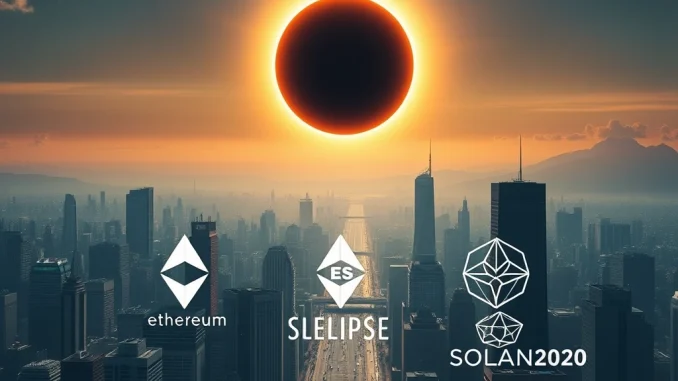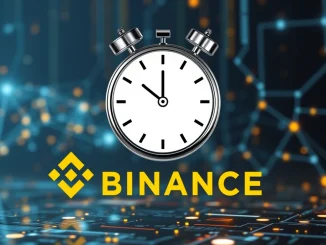
Get ready for a groundbreaking development in the crypto space! Eclipse, the pioneering Ethereum layer-2 network fueled by the blazing-fast Solana Virtual Machine (SVM), is gearing up to launch its highly anticipated ES token. If you’ve been following the evolution of blockchain technology, you know that layer-2 solutions are crucial for scaling Ethereum, and Eclipse is taking a bold step forward by integrating the power of Solana. Let’s dive into what this means for you and the future of decentralized applications.
Unveiling the Eclipse ES Token: What You Need to Know
In a recent community Ask Me Anything (AMA) session and subsequent announcement on X, the Eclipse team, led by community figure Alucard, confirmed the upcoming Token Generation Event (TGE) for the ES token. This marks a significant milestone for the project, transitioning from development and testing to a fully operational ecosystem with its native token. But what exactly is Eclipse, and why is the Eclipse ES token launch such a big deal?
What is Eclipse and Why Solana SVM on Ethereum?
Eclipse is not just another layer-2; it’s designed to be the first Ethereum layer-2 network leveraging the Solana Virtual Machine (SVM). This is a game-changer because:
- Scalability and Speed: Solana is renowned for its high throughput and low transaction costs. By using SVM, Eclipse aims to bring similar performance benefits to the Ethereum ecosystem, addressing the scalability challenges that Ethereum sometimes faces.
- Developer Flexibility: SVM offers a different programming environment compared to Ethereum’s EVM (Ethereum Virtual Machine). This opens up new possibilities for developers, potentially attracting those familiar with Solana’s ecosystem to build on Ethereum.
- Interoperability: Eclipse is designed to be a bridge between the Ethereum and Solana ecosystems, potentially fostering greater interoperability and flow of assets and innovation between these two major blockchains.

The Significance of the TGE Event for the Eclipse ES Token
The Token Generation Event (TGE) is a pivotal moment for any crypto project. For Eclipse, the upcoming TGE event represents the official birth of the ES token and its integration into the network’s functionality. Here’s why you should pay attention:
- Community Participation: TGEs often provide an opportunity for the community to become early holders of the token. This can involve various mechanisms like public sales, airdrops, or other distribution methods. Details of the Eclipse TGE will be crucial for those looking to get involved early.
- Token Utility: The ES token will likely play a central role in the Eclipse network. This could include uses such as:
- Transaction Fees: Used to pay for transactions on the Eclipse layer-2.
- Staking and Governance: Potentially allowing ES token holders to stake their tokens to secure the network and participate in governance decisions.
- Ecosystem Incentives: Rewarding developers, validators, and other participants who contribute to the Eclipse ecosystem.
- Network Growth: A successful TGE can provide Eclipse with the necessary resources to further develop its technology, expand its ecosystem, and attract more users and developers to the platform.
Navigating the Ethereum Layer 2 Landscape with Eclipse
The Ethereum layer-2 landscape is becoming increasingly competitive, with various solutions vying for dominance. So, where does Eclipse fit in, and what makes its Ethereum layer-2 solution stand out?
| Feature | Eclipse (SVM-based L2) | Traditional EVM-based L2s (e.g., Optimism, Arbitrum) |
|---|---|---|
| Virtual Machine | Solana Virtual Machine (SVM) | Ethereum Virtual Machine (EVM) |
| Performance Focus | High throughput, low latency (Solana-inspired) | Improved scalability over Ethereum mainnet |
| Developer Ecosystem | Potentially attracts Solana developers, new programming paradigms | EVM compatibility, large existing Ethereum developer base |
| Interoperability | Aims for strong Ethereum and Solana interoperability | Primarily focused on Ethereum ecosystem |
Eclipse’s unique approach of using the Solana SVM on an Ethereum layer-2 positions it differently from other scaling solutions. While EVM-compatible layer-2s benefit from the vast Ethereum developer community and toolset, Eclipse could attract a new wave of developers and projects seeking Solana-like performance within the Ethereum ecosystem.
The Road Ahead: What to Expect After the Crypto Launch
The crypto launch of the ES token is just the beginning for Eclipse. Here’s what to anticipate in the coming months:
- TGE Details: Keep a close eye on official Eclipse channels for announcements regarding the TGE. This will include information on the date, token distribution mechanism, and any participation requirements.
- Ecosystem Growth: Following the token launch, expect to see increased activity within the Eclipse ecosystem. This could involve new dApps being deployed, partnerships being formed, and community initiatives taking shape.
- Technological Advancements: The Eclipse team will likely continue to develop and refine the network, potentially introducing new features, optimizations, and integrations.
- Community Engagement: Active participation from the community will be crucial for Eclipse’s success. Stay engaged through their social media channels, forums, and developer communities to stay informed and contribute to the project’s growth.
Final Thoughts: Is Eclipse Poised to Reshape Layer-2s?
Eclipse’s innovative approach to building an Ethereum layer-2 with Solana SVM is undeniably exciting. The upcoming launch of the Eclipse ES token and the TGE event are key milestones to watch. By combining the security and network effects of Ethereum with the performance capabilities of Solana, Eclipse has the potential to become a significant player in the layer-2 space. Whether you are a developer, investor, or simply a crypto enthusiast, keeping an eye on Eclipse and its ES token launch is highly recommended. This project could very well be at the forefront of the next wave of Ethereum scaling solutions, bridging ecosystems and unlocking new possibilities for decentralized applications. The fusion of Ethereum and Solana technologies within Eclipse offers a compelling narrative and a promising future. Stay tuned for more updates as Eclipse embarks on this exciting journey!



